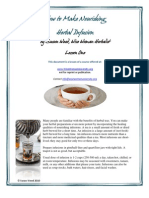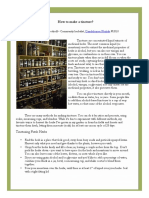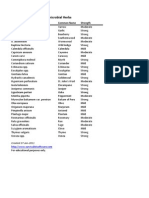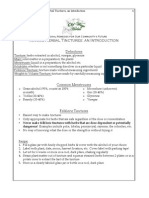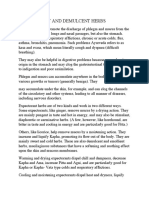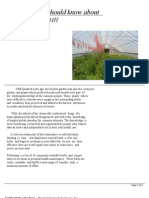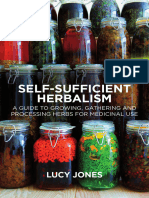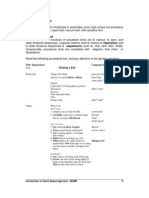Harvesting and Preserving Herbs and Spices For Use in Cooking
Harvesting and Preserving Herbs and Spices For Use in Cooking
Uploaded by
Afrim TonuziCopyright:
Available Formats
Harvesting and Preserving Herbs and Spices For Use in Cooking
Harvesting and Preserving Herbs and Spices For Use in Cooking
Uploaded by
Afrim TonuziOriginal Description:
Original Title
Copyright
Available Formats
Share this document
Did you find this document useful?
Is this content inappropriate?
Copyright:
Available Formats
Harvesting and Preserving Herbs and Spices For Use in Cooking
Harvesting and Preserving Herbs and Spices For Use in Cooking
Uploaded by
Afrim TonuziCopyright:
Available Formats
Harvesting and Preserving Herbs and Spices
for Use in Cooking
Cooks realize that most recipes will require herbs and spices intended for refrigerating, freezing, or drying
spices as ingredients to flavor dishes. Instead of relying should be preserved as soon as possible for the best
on herbs and spices purchased from the grocery store, flavor and color. When storing, remember to label the
gardeners can grow, harvest, and preserve their own. container with the name of the herb or spice and the
The method used for harvesting herbs and spices is date harvested.
dependent on the plant part desired. Separate facts
sheets have been written on each commonly used herb Refrigerating Herbs
with detailed descriptions of the plant part used as well After rinsing, place herbs loosely in a plastic bag, and
instructions for their use in a recipe. Also refer to Herb place the bag in a refrigerator. The herbs will remain
History for definitions of herbs and spices and fresh for a few days to a week. Another method is to
additional historical information. place whole plants or sprigs in a jar or cup with about 1
inch of water, cover the herbs with a plastic bag and
Harvesting place in a refrigerator. If the water is changed daily,
herbs can last up to two weeks using this method.
Tools for harvesting can include hand pruners, a sharp Note: basil (Ocimum basilicum) and oregano (Origanum
knife, or scissors. Your hands will also work well in spp.) should be used on the day harvested because they
pinching off leaves, seeds, or fruits. will not hold well in the refrigerator. Fennel stalks
Leaves should be free of insect damage and other (Foeniculum vulgare) dry out quickly and should be used
blemishes and harvested just after the dew has within 3 to 4 days of harvest.
evaporated from the plant in the morning. Leaves are
at their peak flavor anytime before flowering and Freezing Herbs
develop off flavors after flowering. After rinsing, gardeners have the option of freezing
sprigs, whole leaves, or leaves cut or torn into smaller
If harvesting the entire plant, wait until just before the
sections. Herbs can simply be placed in freezer
flower buds open. If the plant is an annual (see fact
containers or bags and placed in a freezer. Alternatively,
sheet on Nomenclature for more information on
herbs can be placed in a single layer on a cookie sheet
plant life cycles), cut it off at the soil line. If it is
and then frozen. Once the herbs are frozen they can be
perennial, cut off no more that one third of the
placed in freezer containers or bags. This method
stems.
prevents the herbs from freezing in clumps, and it may
Seeds and fruits should be harvested after they reach be easier to remove individual quantities for cooking.
maturity and on a dry day. For most plants, this is In general, blanching herbs before freezing will sacrifice
when the fruit has changed from green to tan, brown, flavor but retain better color. If one opts to blanch,
or black. place the herbs in a colander and pour boiling water
over them for about one second. Basil is one herb that
Preserving should always be blanched. It will blacken if not
blanched prior to freezing. Once frozen, herbs can last
Rinsing and Storing for six months to a year. Generally, herbs will retain
After harvesting, leaves and whole plants should be their flavor though some will change slightly. Frozen
rinsed in cold water and patted dry. Herbs and/or
College of Agricultural Sciences Cooperative Extension
herbs can be used in cooking without defrosting. When Sources
using frozen herbs in uncooked foods, they should be
Billingsley, G. (Ed). 1997. The Packer 1997 Produce
thawed and excess water may need to be drained prior
Availability & Merchandising Guide. Vance Publishing
to adding to the foods. In this case, the texture may be
Corp., Lenexa, KS.
softer than when freshly harvested.
Bown, D. 2001. The Herb Society of America New
Drying Herbs & Spices Encyclopedia of Herbs and their Uses. DK, London.
Dried herbs and spices can last up to a year when Bremness, L. (Ed). 1990. RD Home Handbooks
stored in a cool, dry location. Be sure the herb or spice Herbs. The Readers Digest Association, Inc.,
is completely dried prior to storing. Otherwise, they Pleasantville, NY.
can mold and deteriorate quickly. When drying, the
flavor of strong flavored herbs, such as rosemary Buchanan, R. (Ed). 1995. Taylors Guide to Herbs.
(Rosmarinus officinalis) and sage (Salvia officinalis), will affect Houghton Mifflin Co., Boston.
the flavor of other herbs, so dry strong flavored herbs Kowalchik, C. and Hylton, W.H. (Eds.) 1987. Rodales
away from other herbs. Illustrated Encyclopedia of Herbs. Rodale Press,
Emmaus, PA.
Oven-drying is a quick method to remove water from
herbs and spices; however, during the drying process Prepared by Elsa S. Snchez, assistant professor of
essential oils are lost and therefore some flavor is lost. horticultural systems management and
If using this method, position herbs or spices in a single Kathleen M. Kelley, assistant professor of consumer
layer on a cookie sheet, and place them in an oven set at horticulture
its lowest temperature. The oven door should be left
slightly ajar for air circulation. Turn the herbs or spices Penn State College of Agricultural Sciences
over periodically to promote uniform drying. They are Department of Horticulture
sufficiently dry when they are crisp and break easily. 102 Tyson Bldg.
Avoid over-drying, and cool prior to storage. University Park, PA 16802
September 21, 2002
Microwaving also removes water from the herb or
spice quickly without affecting flavor. Place the herbs
or spices in a single layer between paper towels.
Microwave for up to 4 minutes, turning them over and
checking for doneness every 30 seconds. The paper
towels need to be replaced once they are too moist.
The herbs are sufficiently dry when they are crisp and The Horticulture Fact Sheet series is produced
break easily. Again, avoid over-drying, and cool prior for home gardeners and professionals by the
to storage. Consumer Horticulture Center at Penn State.
The complete series is available on the Web at
Air-drying is another method to preserve herbs and www.hortweb.cas.psu.edu.
spices. One method of air-drying entails tying a string to
the base of a bundle of whole plants, sprigs, or seed Visit Penn States College of Agricultural Sciences on the Web: www.cas.psu.edu.
heads. Make sure the bundle is small enough for Where trade names appear, no discrimination is intended, and no endorsement by
adequate air circulation and uniform drying. Then hang Penn State Cooperative Extension is implied.
the bundle upside down in a warm (68 to 90F), well- Issued in furtherance of Cooperative Extension Work, Acts of Congress May 8 and
June 30, 1914, in cooperation with the U.S. Department of Agriculture and the
ventilated, dry and dark place. The herbs or spices are Pennsylvania Legislature. T. R. Alter, Director of Cooperative Extension, The
placed in the dark because essential oils break down in Pennsylvania State University.
sunlight. A paper bag can be placed over the herbs or This publication is available in alternative media on request.
spices to keep them out of the light, to catch pieces that The Pennsylvania State University is committed to the policy that all persons shall
have equal access to programs, facilities, admission, and employment without regard
may fall, and to keep them free of dust. Alternatively, to personal characteristics not related to ability, performance, or qualifications as
leaves, seeds, and fruits can be placed loosely in a single determined by University policy or by state or federal authorities. It is the policy of
the University to maintain an academic and work environment free of discrimination,
layer on a wire screen, slatted tray, or muslin for drying. including harassment. The Pennsylvania State University prohibits discrimination and
They will need to be turned over periodically for even harassment against any person because of age, ancestry, color, disability or handicap,
national origin, race, religious creed, sex, sexual orientation, or veteran status.
drying. Air-drying can take two weeks or more. As Discrimination or harassment against faculty, staff, or students will not be tolerated at
with other drying methods, the herbs and spices are The Pennsylvania State University. Direct all inquiries regarding the nondiscrimination
policy to the Affirmative Action Director, The Pennsylvania State University, 328
sufficiently dry when they are crisp and easily broken. Boucke Building, University Park, PA 16802-5901, Tel 814-865-4700/V, 814-863-
1150/TTY.
The Pennsylvania State University 2003
You might also like
- Oturupon OturaDocument44 pagesOturupon Oturairelayeo75% (4)
- How To Make A Tincture & Cheat SheetDocument5 pagesHow To Make A Tincture & Cheat Sheetcatalin100% (1)
- The Complete Illustrated Book of Herbs: Growing • Health & Beauty • Cooking • CraftsFrom EverandThe Complete Illustrated Book of Herbs: Growing • Health & Beauty • Cooking • CraftsRating: 4 out of 5 stars4/5 (1)
- Herbalist Course Program Info and SyllabusDocument5 pagesHerbalist Course Program Info and SyllabusAlejandra GuerreroNo ratings yet
- Inula Elecampane Materia Medica HerbsDocument3 pagesInula Elecampane Materia Medica HerbsAlejandra GuerreroNo ratings yet
- How To Make Nourishing Herbal InfusionDocument8 pagesHow To Make Nourishing Herbal InfusionNova9100100% (3)
- 2019 Introductory Herbal Course Outline1Document6 pages2019 Introductory Herbal Course Outline1Erick Lopez100% (3)
- Medicinal Herb Mixtures Herbals Mists: PindariDocument10 pagesMedicinal Herb Mixtures Herbals Mists: PindariMohamad Saadatian SipanNo ratings yet
- Tincture MakingDocument3 pagesTincture Makingfiloumenos75% (4)
- Antimicrobial HerbsDocument1 pageAntimicrobial HerbsmaulladorNo ratings yet
- Apothecary Checklist PDFDocument7 pagesApothecary Checklist PDFhalaken88% (8)
- SZ SiSwati Language LessonsDocument19 pagesSZ SiSwati Language LessonsAfrim Tonuzi0% (1)
- REGULATIONS GOVERNING THE USE OF THE CERTIFICATION MARK OF OZONE FRIENDLY PURE CEYLON TEA2xDocument37 pagesREGULATIONS GOVERNING THE USE OF THE CERTIFICATION MARK OF OZONE FRIENDLY PURE CEYLON TEA2xMahamud Hasan PrinceNo ratings yet
- Food Preparation & Service: Ch. 5 HSDocument15 pagesFood Preparation & Service: Ch. 5 HSImam Faizal Fauzi100% (1)
- Dible Ookie Up: Business ProposalDocument35 pagesDible Ookie Up: Business ProposalTarek TomehNo ratings yet
- My Herbs - Issue 25 2023Document84 pagesMy Herbs - Issue 25 2023Jair Sierra100% (1)
- What Is An Herbal Tincture AnywayDocument2 pagesWhat Is An Herbal Tincture AnywayJenn AngNo ratings yet
- Kitchen Apothecary PDFDocument3 pagesKitchen Apothecary PDFIveri Aura100% (2)
- Medicine Making GuidelinesDocument4 pagesMedicine Making GuidelinesjeslynNo ratings yet
- Grandma S Herbal Remedies 2 - The Secret Recipes - Anton SmiDocument42 pagesGrandma S Herbal Remedies 2 - The Secret Recipes - Anton SmiEnikő Vicsai100% (2)
- Plant Healer 2020 Herbal Education Guide & Schools DirectoryDocument81 pagesPlant Healer 2020 Herbal Education Guide & Schools DirectoryStacey Diane100% (2)
- Damiana Turnera Diffusa Materia Medica HerbsDocument3 pagesDamiana Turnera Diffusa Materia Medica HerbsAlejandra GuerreroNo ratings yet
- BookDocument30 pagesBookMike SharpNo ratings yet
- Immunity Herbs RecipesDocument16 pagesImmunity Herbs RecipesCecilia100% (2)
- Holy Basil Ebook StorageDocument15 pagesHoly Basil Ebook StorageRaluca ScrieciuNo ratings yet
- Making Herbal Tinctures GE2013Document2 pagesMaking Herbal Tinctures GE2013Mateu Gili100% (2)
- The Quick Guide To Herbal Remedies: by Dr. Akilah ElDocument14 pagesThe Quick Guide To Herbal Remedies: by Dr. Akilah ElMagie Alba BioterapiiNo ratings yet
- How To Make An Herbal TintureDocument7 pagesHow To Make An Herbal TintureArtist Metu100% (2)
- American Medicinal Leaves and Herbs - Page 1Document52 pagesAmerican Medicinal Leaves and Herbs - Page 1kevgNo ratings yet
- Expectorant and Demulcent HerbsDocument3 pagesExpectorant and Demulcent HerbsqueencelNo ratings yet
- Contraindications Herbal Remedies 2018Document8 pagesContraindications Herbal Remedies 2018skylarkmdNo ratings yet
- A Guide To Herb Teas and Their UsesDocument40 pagesA Guide To Herb Teas and Their UsesCallum Young100% (2)
- 10 Herbs You Should Know About: by Debra Nuzzi, MHDocument4 pages10 Herbs You Should Know About: by Debra Nuzzi, MHjeffreyyewcic100% (2)
- YCH Herbal Medicine CabinetDocument24 pagesYCH Herbal Medicine CabinetTravis Stinnett100% (4)
- Herbs You Should GrowDocument7 pagesHerbs You Should Growjimbob1233No ratings yet
- Fire Cider Immune TonicDocument11 pagesFire Cider Immune TonicСергей ГончаренкоNo ratings yet
- Catnip Nepeta Cataria Materia Medica HerbsDocument10 pagesCatnip Nepeta Cataria Materia Medica HerbsAlejandra GuerreroNo ratings yet
- Herb Safety Herbalist HerbalismDocument28 pagesHerb Safety Herbalist HerbalismAlejandra Guerrero100% (1)
- Survivalists Herbal FormulasDocument30 pagesSurvivalists Herbal Formulaskim_peyote100% (10)
- Herbal Antibiotics What Everybody Ought To Know About These Powerful Herbal Remedies Little Known Wa - 1Document91 pagesHerbal Antibiotics What Everybody Ought To Know About These Powerful Herbal Remedies Little Known Wa - 1ash79No ratings yet
- Herbal Bitters RecipeDocument6 pagesHerbal Bitters RecipeIveri AuraNo ratings yet
- Herbology EbookDocument107 pagesHerbology EbookPraveena Mogan100% (4)
- How To Make Wines at Home - Using Wild and Cultivated Fruit, Flowers and Vegetables (PDFDrive)Document148 pagesHow To Make Wines at Home - Using Wild and Cultivated Fruit, Flowers and Vegetables (PDFDrive)angelobuffalo100% (1)
- Self Sufficient Herbalism A Guide To Growing, Gat Z Lib OrgDocument339 pagesSelf Sufficient Herbalism A Guide To Growing, Gat Z Lib OrgMatheus Ferreira100% (7)
- Hibiscus High Flavanoid Herbs Materia MedicaDocument6 pagesHibiscus High Flavanoid Herbs Materia MedicaAlejandra GuerreroNo ratings yet
- Foyaging - Edible Wild Grasses, Plants and Herbs - UnknownDocument21 pagesFoyaging - Edible Wild Grasses, Plants and Herbs - UnknownagabattiNo ratings yet
- Herbal Medicine Making KitDocument33 pagesHerbal Medicine Making Kitxiuhtlaltzin71% (7)
- All ABout Herbs 3Document26 pagesAll ABout Herbs 3Dame100% (1)
- Herbal Its Project Biology.....Document52 pagesHerbal Its Project Biology.....MISHANo ratings yet
- Medicinal Importance of WeedsDocument6 pagesMedicinal Importance of WeedsCELIN MATHEW100% (1)
- Useful Herbs For Small Gardens: - Anna BrazierDocument14 pagesUseful Herbs For Small Gardens: - Anna BrazierGift Simau100% (1)
- Harpagophytum Devils Claw Materia Medica HerbsDocument3 pagesHarpagophytum Devils Claw Materia Medica HerbsAlejandra GuerreroNo ratings yet
- 10 Approved Herbal MedicineDocument3 pages10 Approved Herbal MedicineAriel-jay Naungan100% (1)
- Herbal AntibioticsDocument180 pagesHerbal Antibioticsfg77100% (6)
- Medicinal PlantsDocument17 pagesMedicinal PlantsChristopher PartingtonNo ratings yet
- DIY Homemade Herbal Antibiotics and Antiviral - A Comprehensive Guide To Herbal and Homemade Remedies Antibiotics and AntiviralDocument49 pagesDIY Homemade Herbal Antibiotics and Antiviral - A Comprehensive Guide To Herbal and Homemade Remedies Antibiotics and AntiviralBojan Adžić100% (3)
- MedicinesDocument1 pageMedicinessyaz09No ratings yet
- Herbs-Sam CoffmanDocument9 pagesHerbs-Sam CoffmanSilambarasu Karuppiah50% (2)
- Osceola Naranjo, Linda - The Native American Herbalist's Bible - 3-In-1 Companion To Herbal Medicine (Theory and Practice, Field Book, Herbal Remedies) - Self-Published (2021)Document387 pagesOsceola Naranjo, Linda - The Native American Herbalist's Bible - 3-In-1 Companion To Herbal Medicine (Theory and Practice, Field Book, Herbal Remedies) - Self-Published (2021)Andrea Davila100% (5)
- Druggist ManualDocument136 pagesDruggist ManualTony DunsworthNo ratings yet
- Natural Remedies: Homemade Organic Remedies for Your Health and Appearance to Prevent and Heal Sickness: Herbal & Natural CuresFrom EverandNatural Remedies: Homemade Organic Remedies for Your Health and Appearance to Prevent and Heal Sickness: Herbal & Natural CuresNo ratings yet
- Make Your Own Affordable Ancient Potent Herbal Medicine And EdiblesFrom EverandMake Your Own Affordable Ancient Potent Herbal Medicine And EdiblesNo ratings yet
- ALBANIA InformationDocument14 pagesALBANIA InformationAfrim TonuziNo ratings yet
- Cig TG Budgeting Mar08Document16 pagesCig TG Budgeting Mar08Afrim TonuziNo ratings yet
- Franschhoek Food Wine Route PDFDocument2 pagesFranschhoek Food Wine Route PDFAfrim TonuziNo ratings yet
- Serbias 1937 Plan To Expel AlbaniansDocument3 pagesSerbias 1937 Plan To Expel AlbaniansAfrim TonuziNo ratings yet
- Franschhoek Food Wine Route PDFDocument2 pagesFranschhoek Food Wine Route PDFAfrim TonuziNo ratings yet
- Overview of Verb Tenses-3Document4 pagesOverview of Verb Tenses-3Afrim TonuziNo ratings yet
- Exercises in Formal and Informal English Pronunciation Exercises Phonics 39694Document3 pagesExercises in Formal and Informal English Pronunciation Exercises Phonics 39694Afrim Tonuzi100% (1)
- Top 10 Tips For Making The Best Cookies PDFDocument7 pagesTop 10 Tips For Making The Best Cookies PDFAfrim TonuziNo ratings yet
- Erg 07 14 Annual Report 2006Document16 pagesErg 07 14 Annual Report 2006Afrim TonuziNo ratings yet
- Improving The Operation of Urban WaterDocument4 pagesImproving The Operation of Urban WaterAfrim TonuziNo ratings yet
- European Regulators Group: Annual Report 2007Document18 pagesEuropean Regulators Group: Annual Report 2007Afrim TonuziNo ratings yet
- Erg0516 Erg Annual Report 2004Document11 pagesErg0516 Erg Annual Report 2004Afrim TonuziNo ratings yet
- Erg 08 45 Action Plan To Achieve Conformity With The Common Position On MTRFTR SymmetryDocument37 pagesErg 08 45 Action Plan To Achieve Conformity With The Common Position On MTRFTR SymmetryAfrim TonuziNo ratings yet
- Erg 07 54 WLL CP Final 080331Document12 pagesErg 07 54 WLL CP Final 080331Afrim TonuziNo ratings yet
- Erg 06 70 Rev1 Wla CP 6 June 07Document10 pagesErg 06 70 Rev1 Wla CP 6 June 07Afrim TonuziNo ratings yet
- Erg 06 19 Explanatory Memorandum Revised Erg Common Position On RemediesDocument9 pagesErg 06 19 Explanatory Memorandum Revised Erg Common Position On RemediesAfrim TonuziNo ratings yet
- Erg 07 53 Wla Wba BP Final 080604Document40 pagesErg 07 53 Wla Wba BP Final 080604Afrim TonuziNo ratings yet
- Erg 09 07 Report On The Discussion of The Application of Margin Squeeze Tests To BundlesDocument25 pagesErg 09 07 Report On The Discussion of The Application of Margin Squeeze Tests To BundlesAfrim TonuziNo ratings yet
- Erg 08 20 Final CP Geog Aspects 081016Document24 pagesErg 08 20 Final CP Geog Aspects 081016Afrim TonuziNo ratings yet
- Erg 06 39 Report Voip Cons AspectsDocument61 pagesErg 06 39 Report Voip Cons AspectsAfrim TonuziNo ratings yet
- Pork TocinoDocument16 pagesPork TocinoDindo Zaragoza100% (3)
- Avril Lavigne - We Are Warriors (Official Video) - YoutubeDocument5 pagesAvril Lavigne - We Are Warriors (Official Video) - YoutubeFranky SetionoNo ratings yet
- Reaction PaperDocument5 pagesReaction PapermigoogooNo ratings yet
- Mahashivaratri Sadhana English FinalDocument4 pagesMahashivaratri Sadhana English FinalSalai Sundar RamanujuluNo ratings yet
- Swot Analysis Examples: To Help You Write Your OwnDocument25 pagesSwot Analysis Examples: To Help You Write Your OwnKassandra KayNo ratings yet
- Isagi Vs The BL WorldDocument34 pagesIsagi Vs The BL Worldanisasyira06No ratings yet
- Cooking Korean Food With Maangchi - Book 3 (Revised 2nd Edition)Document144 pagesCooking Korean Food With Maangchi - Book 3 (Revised 2nd Edition)Maangchi100% (4)
- Divoflow 185 enDocument2 pagesDivoflow 185 enHau SinâuđaNo ratings yet
- Excise Notification No 1004Document4 pagesExcise Notification No 1004Bonifacedesign projectsNo ratings yet
- Unit 5 Phy 2 EsoDocument1 pageUnit 5 Phy 2 EsoVirginia Gómez RojasNo ratings yet
- BLEACH Charac Part 2.Document67 pagesBLEACH Charac Part 2.Al Lan100% (1)
- UroojArshad Nestle1Document14 pagesUroojArshad Nestle1UROOJ ARSHADNo ratings yet
- Audit and Assurance (United Kingdom) : Thursday 5 December 2013Document6 pagesAudit and Assurance (United Kingdom) : Thursday 5 December 2013Hibah RajaNo ratings yet
- Reviewer Cookery 9Document77 pagesReviewer Cookery 9Genelyn Lucena Hurtada LabindaoNo ratings yet
- Analysis of SugarsDocument29 pagesAnalysis of SugarsFendi Zola HendrawanNo ratings yet
- Pages From Introduction To Genre Based Approach Part 2Document15 pagesPages From Introduction To Genre Based Approach Part 2veeaNo ratings yet
- Soal Bahasa Inggris Kelas XDocument7 pagesSoal Bahasa Inggris Kelas XUcie PradanaNo ratings yet
- Products Retail Price Reseller Price BOX: Unit Price Dimension Banana CakeDocument11 pagesProducts Retail Price Reseller Price BOX: Unit Price Dimension Banana CakeAnjo Balucas100% (1)
- ANL Magazine SEPT 2012Document14 pagesANL Magazine SEPT 2012dalee_edwards0% (1)
- BHR 331 201800617 TestDocument4 pagesBHR 331 201800617 TestParks WillizeNo ratings yet
- Đề Thi Học Kì 2 1-5 Friend Plus G6Document15 pagesĐề Thi Học Kì 2 1-5 Friend Plus G6Phung NguyenNo ratings yet
- Pratap New ResumeDocument2 pagesPratap New ResumepratapcocacolaNo ratings yet
- Segredos Da ChrisDocument2 pagesSegredos Da ChrisallysonlucaasNo ratings yet
- 4th CM Health 8Document2 pages4th CM Health 8Cloue Faye I. BasalloNo ratings yet
- Teste Grila EnglezaDocument4 pagesTeste Grila EnglezaAlexandra EvaNo ratings yet
- Week 2 Welcome To The Lord's TableDocument10 pagesWeek 2 Welcome To The Lord's TableShower of RosesNo ratings yet





